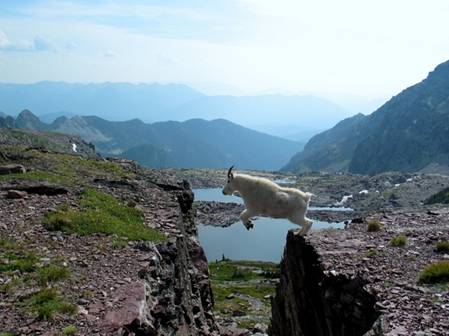The mountain goat is an ungulate, or hooved mammal of the order Artiodactyla – or “even toed” – basically a hoof that is split into two parts. The mountain goat is the only species in the genus Oreamnos, which is derived from the Greek term oros (stem ore-) “mountain” or oreas for “mountain nymph, and the word amnos for “lamb”.
Hooved animals are basically walking on their toenails, having an extended foot bone structure. The split hooves of Artiodactys are homologous to the third and fourth digits of our hand/foot. Goats are very sure-footed in airy places, helped by their hooves, which are hard on the outside with soft inner pads.
Males and females have beards and black horns, which are made of keratin – the same protein that forms fingernails and hair on us. Horns are not shed and grow continuously – in contrast antlers (such as on deer/moose) are shed every year. Size can vary by location but males can average around 180 lbs and females around 155 lbs.
They have a double coat of fir with a dense under coat and an outer coat of long, hollow hairs that is shed each spring. These are alpine animals, spending the vast majority of their life above tree line and able to cope with winter temperatures as low as -50° F. In winter they will venture lower and are often attracted to natural salt licks – more on this in a bit. They are herbivorous and eat a variety of grasses, sedges, herbs, ferns, mosses, and lichens.

oats range from SE Alaska, through B.C. and into the Cascade, and Rocky Mountains in Washington, Idaho, and Montana. Populations have been introduced into a number of other states. An introduced population occurs in the Olympic Mountains of Washington and is having some dire effects on rare alpine plants that did not evolve with this large mammal. In the 1990s there was an effort to eradicate this population but it quickly ran into public opposition and was halted.
They will mate in late autumn and the males will often get into dominance scuffles. Males have glands at the base of their horns that extrude an oily material that they rub on vegetation to mark their territory. Scuffles may lead to injuries from horns, but it is more often a show of dominance and one or the other male will just back down. Following the mating season the males go off on their own again and the females will raise the kids. Single kids are born in the spring – but twins are not uncommon. Within a couple hours they are up and about and able to keep up with their mother.
Predators include wolves, wolverines, bears, and cougars. Golden eagles have been observed knocking young goats off ledges and then feeding on the carcass. Here’s a short video of young goats goofing around and mom shedding her winter coat: http://www.youtube.com/watch?v=vyrK1tyNWqU
Goats and other ungulates often are attracted to natural mineral/salt licks that provide mineral nutrients lacking in nutrient-poor environments. These mineral licks can provide essential sodium, calcium, iron, phosphorous, and zinc need for bone/muscle development. Human sweat also is a salt source so goats will lick/chew unattended clothes, boots, and packs and will gnaw on wooden handrails. A friend sleeping without a tent was once awaken by a goat licking his face for the salt – a big, old, smelly billy-goat – what a wakeup call!
They also have an affinity for, well, human pee – because of its salt content. Agency advice for when in goat-country is to pee away from the trail so the trail corridor doesn’t become an attractant – and on a rock so ground vegetation is not disturbed. I’ve done a fair amount of alpine climbing in the Cascades and have seen the goats up close. The first photo is from the upper Enchantments Basin, which is chock full of goats.
Up in the Enchantments, when you felt the need to “go” you would first look around and then have at it, only to hear the thump, thump, thump of the unseen goats coming your way. They would then pause and wait patiently for you to finish. One time my female climbing partner and I were on a narrow ridge getting ready to climb down a steep snowfield to access a series of ledges on Mt. Maude in the North Cascades. I turned around to look at the view while she needed to pee before we ventured off – sure enough a goat showed up and stood two feet away, looking her in the eye, just waiting, waiting, and waiting – despite her calls of shoo! shoo! I’ve also had them bully their way past me on a narrow, airy ledge.
Humor aside, there are good reasons to be cautions around goats. An experienced elderly hiker was killed a couple years ago on Hurricane Ridge in Olympic National Park, which is a popular hiking area. A male goat was acting aggressively so the hiking group decided to head down and this gentleman was in the back keeping an eye on the goat when it charged and severed his femoral artery. There was a similar experience in the Olympics on Mt. Ellinor, when a hiker was stabbed in the leg but no major damage was done, and his friends helped him hobble the several miles back to the car.
So I’ll paraphrase the USFS, BLM, and NPS advice here:
· Never feed goats
· Keep your belongings – lunch, pack, hiking poles – close by.
· In the summer if a goat approaches yell, wave, and shoo it away.
· Pee away from trails and on rocks.
· In the autumn (breeding time) if a goat approaches – slowly retreat.
While they are beautiful and are quite the icon of the mountains, don’t treat them too casually – they are large and strong animals.
